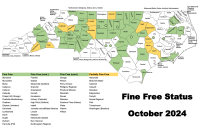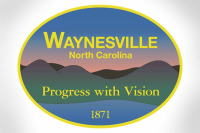New GSMNP visitor center is worth a trip
This past Friday (April 15) I attended the dedication ceremony for the new Oconaluftee Visitor Center on the North Carolina side of the Great Smoky Mountains National Park near Cherokee. I wouldn’t normally enjoy a program made up of eight or so speeches, but as this one proceeded I found myself smiling.
I was pleased that the North Carolina side of GSMNP finally has a real visitor center. I was pleased that the directors, board members, and general membership of the Great Smoky Mountains Association and Friends of the Great Smoky Mountains National Park received due recognition in regard to raising private funding that totaled $3 million. And I was pleased that it was such a nice friendly-looking building — the sort of public facility you’d enjoy visiting with your mother or your children or by yourself.
I tried after the dedication to tour the exhibit area. But I couldn’t get into it ... too many people I knew … too many distractions. So I left and came back Sunday afternoon. I don’t know anything about the nitty-gritty of designing buildings or planning exhibits. I do love museums of almost any sort, ranging from the grand old Smithsonian in the nation’s capital to the delightful county museum housed in a basement in Murphy. I’ve probably been through the nearby Museum of the Cherokee Indian at least 20 times, with groups or on my own. Here then are some random impressions of the new OVC.
Many traditional museum exhibits are driven by printed sources; that is, the designers read the significant books about a given event or place and use that information to present (in enclosed wall or glass-topped table displays) a chronological account based on — and quoting extensively from — those sources.
The new OVC exhibits are refreshingly free of that semi-academic approach. The only authors allowed even a sentence or two are Francis Asbury, Horace Kephart, Paul Fink and John Parris. (James Mooney, author of the monumental Myths of the Cherokees published in 1900, probably did deserve a word.) Instead, the new OVC exhibit is thematic — depicting via “Mountain Voices” how lands within and related to the park have been used through time by various peoples in various ways — as they sought to establish homelands suitable to their needs. As such, it necessarily tells the story of the ongoing relationship between the Cherokees, the white settlers, and their respective descendents.
Displays are devoted to Cherokee lore, Trail of Tears, Civil War, logging, moonshine, household and farm implements, family relationships, trails and roads, mills, CCC camps, natural history and more. The sounds of voices and music are literally in the air, not as white noise but as an integral part of the presentation. It is, in fact, more of an active “presentation” than static “display.”
Related Items
The planners clearly strived for diversity in regard to presentation. Layers of often-interactive information are presented via video, print, artwork, maps, photos and voice recordings. Some exhibits, for instance, are designed as hands-on oversized notebooks, while others roll or spin with illustrated sequences. There are free-standing information boards and several video screens along with traditional enclosed wall displays. I can’t pretend to have absorbed a very high percentage of the overall content. After about an hour of looking my brain was saturated.
The primary exhibit area consists of a round kiosk inside a large room. Foot traffic flows clockwise and counterclockwise around the outside and within the kiosk. There is a chronological component, but the individual visitor isn’t locked into a predetermined route. I liked that aspect. I like to ramble around, and I noticed that not a few of my fellow visitors had chosen to wander with me backwards in time from 2011 AD to circa 1000 AD.
Many reading this will remember the oversized (perhaps 4-by-10 feet) raised relief map of the GSMNP that resided on a table in the old OVC. It looked like it had been constructed with mud overlaid with dull green enamel paint. That monstrosity has been replaced in the new OVC by a terrific raised relief map that depicts the topography of the park and adjacent areas in considerable detail.
Aside from perhaps adding a quote from Mooney, I have one other suggestion. Whenever I conduct natural history workshops for the Smoky Mountain Field School, participants are always curious about where the GSMNP is situated in regard to the Appalachians as a whole. It might be useful if a free-standing information exhibit placed near the new map delineated the geographic location of GSMNP as one of the numerous mountain ranges on the western front of the Southern Blue Ridge Province in the Southern Appalachians.
The only notes I made consist of a list of distinctive first names belonging to various individuals quoted or cited in the exhibit: Pettybone, Runaway, Fonzie, Milas, Dulcie, Aden and others. Runaway’s last name was Swimmer. Did he runaway from home or from being transported to Oklahoma?
As I was leaving the exhibit area, I spotted a quote by someone named Winifred. Bending over for a closer look, I saw that it had been spoken by my now deceased friend Winifred Cagle, who grew up on Toms Branch, a tributary of Deep Creek north of Bryson City within what became GSMNP. When I knew him, Winifred lived just outside the park on East Deep Creek. He was very proud of his old home place in the Smokies. And he was a great supporter, in his quiet manner, of the park.
The quote, which I didn’t have to write down, concerns a special salve his mother made that was so good it would cure leprosy, if need be. “It would, in fact,” Winifred advised me on several occasions when we were visiting his old homesite, “cure most anything but a broken heart.”
Winifred spoke in a high-pitched lyrical voice, almost a stammer, that was memorable. Mark Cathey, the renowned fly fisherman who also grew up on Deep Creek, reportedly spoke the same way. I can hear Winifred now. He would be tickled pink to know his mother’s salve has been memorialized in the new visitor center.
George Ellison wrote the biographical introductions for the reissues of two Appalachian classics: Horace Kephart’s Our Southern Highlanders and James Mooney’s History, Myths, and Sacred Formulas of the Cherokees. In June 2005, a selection of his Back Then columns was published by The History Press in Charleston as Mountain Passages: Natural and Cultural History of Western North Carolina and the Great Smoky Mountains. Readers can contact him at P.O. Box 1262, Bryson City, N.C., 28713, or at This email address is being protected from spambots. You need JavaScript enabled to view it..









